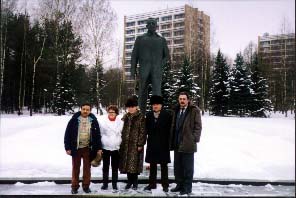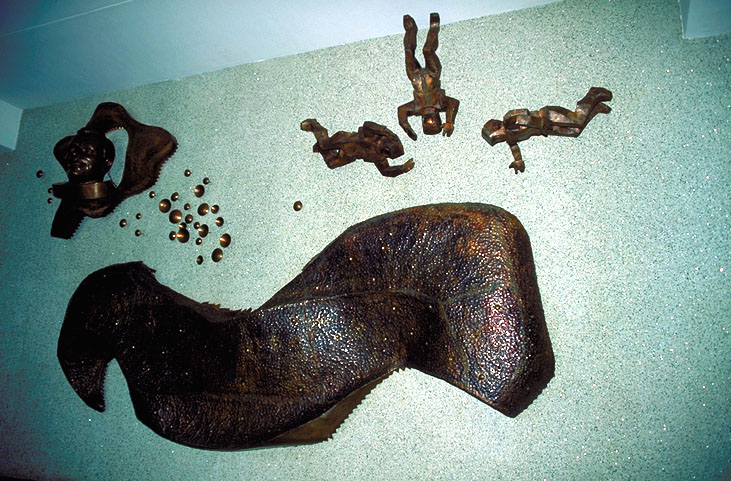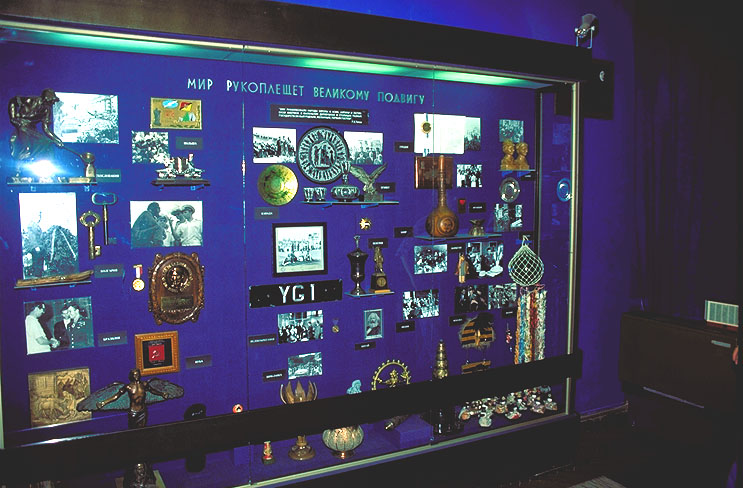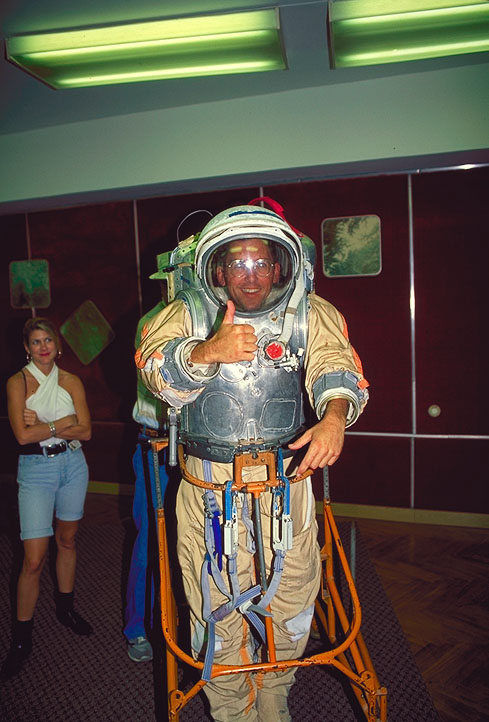|
Star City
|
By Brad Butler
airrally@yahoo.com
|
 |
"Here the organizers, especially as foreigners, were accorded the rare
privlege of placing a wreath at the statue of Soviet Space hero and
pilot, Yuri Gagarin. He was the first man in space and is still
regarded as great hero, but for our World Flight the main thing is that
Gagarin was first and foremost a pilot. Organizers went home from
these January 1992 meetings very confused as Russia had only just
returned after 70 years and the whole government was in disarray.
Gagarin was tragically killed in a flying accident with his favorite
instructor in 1968."
|
|
The Yuri Gagarin statue at Star City in January 1992. |
One of the most unexpectedly fascinating parts of our World Flight was visiting Star City after our
the reception at the City Council chambers with the Mayor of Moscow, Yuri Luzhkov. We had of been told
of the tour and were eagerly awaiting to see the hallowed ground of the Soviet space program, but it was far
more interesting, far more chilling and far more intriguing than any of us expected.
During the mid-1950s the West had warnings of an impending Soviet satellite launch, but these were
ignored in a time of shrinking military budgets during the Eisenhower administrations until the Soviets
launched Sputnik 1 in October 1957. America's Vanguard project had been under funded and did not operate
on the presumption of a space race,' while at the same time the Soviets had announced their intention to
launch in August 1955 at the Sixth International Astronautical Congress in Copenhagen. Chairman of the
Soviet commission Leonid I. Sedov said, "In my opinion, it will be possible to launch an artificial satellite of
the Earth within the next two years, and there is technological possibility of creating artificial satellites of
various sizes and weights."
World opinion assumed, since American setbacks were well known and Soviet information non-existent, that the U.S. would launch first, thus further increasing the shock of the Sputnik launch. The 184
pound Sputnik circled the Earth every 1« hours in an elliptical orbit at altitudes of 140 to 560 miles, carrying
equipment to measure density and temperature in the upper atmosphere. It disintegrated on January 4, 1958
upon hitting the atmosphere and in dramatic fashion the Space Race was on and some of the most intense
episodes of the Cold War moved into the laboratories and amongst the stars.
Although launches did not take place at Star City, this facility, which looks like a Midwestern college
campus, is the primary training and research center where such men as former German scientist Herman
Grottrup played such a key role in the Soviet program after being captured by the Russians at the end of
World War II. Principal among the Germans procured by the Western Allies was brilliant Wernher Von
Braun and his colleague Dorenberger, who both surrendered to the Americans with 150 personnel with
thousands of top secret documents.
|
Soviet Space Art in lobby of MIR Mock up building. |
 |
|
"An example of classic mid-1960s art proclaiming Soviet Space
achivement. This particular piece is displayed in the lobby of the MIR
mock-up building at Star City. All the participants were struck by now
much the Soviet program got out of basic technology, and as of this
writing, in September 1999, the MIR Space Station has been abandoned by
the Russians. It lasted years longer than expected and yielded a
wealth of valuable information which will be applied to the new
international space station being build with a Russian-U.S.
partnership. A long way from Sputnik and standing nose-to-nose at
Checkpoint Charlie in East Berlin."
|
In an operation of supreme importance the Americans quietly raced into the Soviet occupation zone
and moved 50 V-2 rockets, while the Red Army pressed in from the east, and shipped them home for
research. The Germans worked at a secret base in the southwest under tight security and laid the ground work
for the great successes of the U.S. space program which continues with the Space Shuttle and a Space Station
under construction in partnership with Russia, although the Russian phase is years behind schedule and
hopelessly over budget.
In History of Rocketry and Space Travel Wernher Von Braun and Frederick Ordway III offer a
view of rockets, "While writers of science fiction used geese, bottles of dew, spirits, and chariots to carry
their heroes to the Moon, the device that would finally make the trip possible was undergoing a slow but
steady evolution, changing from toy to a weapon, from a crude device to a relatively sophisticated machine.
The time was to come when the rocket would take its place as the only possible means of space
transportation.
"The rocket is a reaction device, which works in accordance with Sir Isaac Newton's Third Law of
Motion: For every action there is an equal and opposite reaction. A rocket can be compared to a continuously
firing machine gun mounted on the rear of a rowboat. As the gun is fired to the rear, the recoil from the
stream of bullets moves the boat forward. A rocket-motor's bullets' are minute particles that are thrown out
through a nozzle as a propellent is burned in a suitable chamber. The reaction to the discharge of these
particles make the rocket fly in the opposite direction.
"Although a rocket is a reaction device, not all reaction devices are rockets. A rocket is a special
case because it contains all the elements it needs to operate, including both fuel and oxygen. A jet airplane
engine, by contrast, is a reaction device that uses the oxygen in the air to support the combustion of the fuel
carried on board. The reaction principle was known long before a true rocket was invented. In his Noctes
Atticae (Attic Nights), Aulus Gellius describes the ancient pigeon of Archytas, dating back to about 360 B.C.
Hanging from a string, the pigeon was made to move by steam blowing from small exhaust ports."
|
Yuri Gagarin Memory Case in the Yuri Gagarin Museum at Star City.
|
 |
|
"Here is the Yuri Gagarin Memory Case in the museum he founded.
Gagarin was the museum's first guide and you might notice the YG1
license plate given to him by the British, one of many awards from
around the world displayed here. Also in the case is a replica of the
house Gagarin grew up in built out of matchsticks, a boy who was
terminally ill constructed it and sent to the great Soviet hero. The
youngster died but his work lives on at Star City."
|
When our group went to Star City in mid-July 1992 it was on a bus that progressed from Moscow
through the wide open countryside to small lonely roads weaving through thick forests of tall thin trees.
Breathing secrecy and deception it hardly seemed possible that we were visiting such a place. In a land of
mystery, where even the story of WWII was shrouded for strategic purposes, Soviet authorities guarded this
place with utmost care. Erecting dummy space centers built to fool high altitude photography of the U2, SR-71, and later spy satellites, the Russian penchant for deception regarding their facilities almost proved fatal to
our group in Siberia in 1992.
One wonders how many double-agents and spies existed at Star City and if they survived, one
wonders how many people died keeping the secrets of Star City, and one wonders what consequences these
events will still have? Military guards are posted at the front gate, a small stone and wood guard house
decorated with a Red Star denotes the entrance, where a large wooden gate moves up as the bus slowly creeps
into this isolated facility. Star City looks deserted as we move into a small enclosed city tucked away in the
countryside outside of Moscow, on all sides are groups of high rise dormitory buildings mixed with wide
walkways separated by large areas of grass.
|
Doug McDaniel tries on a Soviet Space suit as Gina looks on.
|
 |
|
"This picture was taken after we watched an informative video about the
hydro-laboratory training center, which contains 5,000 cubic meters of
water and allows the Cosmonauts to train in a gravity free in
environment and, just as important, in "real time." Doug gives the
pilot's traditional "thumbs up" signal after squeezing into the suit
from behind, in fact when the lovely Mabele got in the suit the suave
Italian general swept her hand and gave her a kiss."
|
The group heads for the sacred statue of Soviet space hero Yuri Gagarin, where Paul and Eric were
accorded the great honor of laying a wreath during their winter visit in January. Foreigners are rarely given
this privilege as Yuri Gagarin is both legend and hero to the Russians and especially to the Cosmonauts, but
of possibly more importance to our story is that first and foremost Yuri Gagarin is a pilot. His statue
occupies a special place both physically and emotionally at Star City. While getting their pictures taken in
front of the statute with our Cosmonaut hosts, we learn that Star City is deserted because of a French-Russian
launch to link-up with the MIR Space Station is about to take place in another part of Russia.
Bob Leavelle give his view of the tour. "7/14. . . . The Space Center. . . . Moscow's Cape Canaveral.
. . . couldn't believe it. . . . we are treated like dignitaries. . . . Vladimir Lyakhov and Igor Volk. . . . two of the
most famous of Russian cosmonauts took us right to the training capsule. . . . all the pictures you want. . . .
thought this would be super secret stuff. . . . they provide lunch. . . . salad, hot dog, and one hard fried egg. . . .
good. . . . Yuri Gagarin, the first man in space is their hero. . . . his picture and statue is everywhere. . . . I get
the occasion to talk with Igor Volk for 10 or 15 minutes. . . . interesting fellow. . . . was up in space 10 years
ago. . . . walks on crutches. . . . result of auto accident. . . . married. . . . family. . . . wife and 3 children. . . .
wants to visit USA."
The tour which followed was eye-opening and educational, a look at a part of the Soviet given to few
individual and we were lucky enough to see it a crucial turning point in world history.
A World Flight Over Russia Home Page
©
The Aviation History On-Line Museum
1999 All rights reserved.



